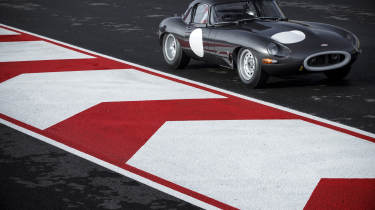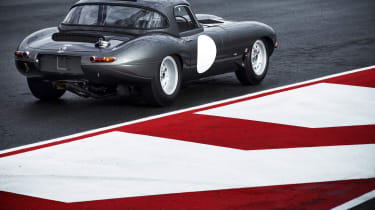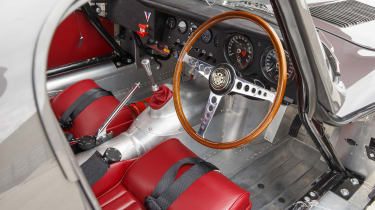Watch - £1.2million Jaguar Lightweight E-Type driven
Impossibly rare and beautiful, on the limit in the magnificent E-Type; watch our video here
The recently formed Jaguar Heritage department are creating the six ‘missing’ Lightweight E-Types. They’re FIA approved to race in historic championships, built with stunning attention to detail and cost ‘deep into seven figures’. The most expensive Jaguar ever, then. The best? We drove Car One on the Navarra circuit in Spain to find out.
What is it?
A ghost from the past made real. The original ‘Special GT E-Type’ project was devised in ’63. The steel monocoque and body of the E-Type would be replaced by hand made aluminium panels, spot welded and riveted together. The engine would be a dry-sumped aluminium block version of the 3.8-litre ‘XK’ straight-six. The resulting Lightweights were homologated at 960kg and 18 were to be built… In ’63 and ’64 just 12 were delivered. Six chassis numbers assigned to Lightweights were left dormant and remained blank in Jaguar’s own ledgers. Now Jaguar Heritage – a relatively new operation opened under JLR’s Special Vehicle Operations umbrella – has revived those chassis numbers and will complete the original intended run.
So the basics are 960kg dry or around 1040kg with fluids and fuel, around 340bhp and 280lb ft from a brand new 3.8-litre straight six (you can choose Lucas mechanical fuel injection or carbs, just as you could in ’63) and full FIA homologation for historic racing. The price? Well into seven figures. But then an original would probably set you back around £6-million…
Technical highlights
The new Lightweights are hand built, first at Jaguar’s Whitley plant, where the aluminium panels are shaped and riveted and spot welded together and mated to the tubular engine subframe. Then the chassis is taken to Gaydon for paint and finally the car is married to its drivetrain and finished at Browns Lane, just yards from where the originals would have taken shape. It’s a meticulous operation and these new Lightweights are built with a precision and quality that is way beyond early 60s racecar standards.
More reviews
Group tests
- Alpine A290 v Alpine A110 – how much DNA do they really share?
- Ariel Atom 4R v Caterham Seven ‘evo25’: power-to-weight heroes go head-to-head
- Aston Martin Vantage vs Audi R8 V10 RWD – back to basics
- Caterham Super Seven 600 v Super Seven 2000
- Levante v T1
- Corvette Stingray v Porsche Cayman GTS v Audi R8 RWD
- Great Ferrari hypercars driven: 288 GTO, F40, F50 and Enzo head-to-head
- Lamborghini Aventador Ultimae v Lamborghini Countach
- Lotus Emira v Morgan Plus Four – four-cylinder Brits go head-to-head
- Toyota GR86 v BBR Mazda MX-5: supercharged drop-top battles sports coupe
In-depth reviews
- Abarth 600e 2025 review – Italy gives the Alpine A290 something to worry about
- Alpine A110 review – distinctive, lightweight and unforgettable to drive
- Audi RS7 Sportback Performance review
- Bentley Continental R Mulliner: review, history and specs
- BMW 5-series review – is this still Munich’s anchor model?
- BMW 1-series review – Munich’s Audi A3 rival gains focus
Long term tests
- Abarth 695C Turismo Fast Fleet test – 10,000 miles in the Italian hot hatch
- Alfa Romeo Giulia Veloce Fast Fleet test – 7000 miles in the sharp Italian saloon
- Alpina B10: end of term report
- Alpina B10
- Ford Mustang GT
- Ford Mustang GT
- Ford Mustang GT
- Land Rover Defender 110 Fast Fleet test – 9000 miles in the go-anywhere SUV
- Maserati Ghibli Trofeo Fast Fleet test – 4000 miles in the Ferrari-powered saloon
- Mitsubishi Evo MR 340
Review
- New Aston Martin DBS 770 Ultimate review – 759bhp super-GT driven
- New Bentley Batur 2023 review – can it possibly be worth £1.65m?
- 2023 Chevrolet Corvette C8 Z06 review – the American 911 GT3?
- Kia EV6 GT-Line S prototype review – the EV that shows how it’s done
- BBR Supercharged Mazda MX-5 (ND) 2023 review – tuned 250bhp roadster driven
- MG4 Trophy 2023 review
Reviews
- Abarth 695 75 Anniversario edition 2024 review – a fitting send-off for Abarth’s hot supermini?
- Abarth 500e 2023 review
- AC Cobra 378 Superblower MkIV 2021 review – another V8 Cobra, but with a GM heart this time
- Acura Integra Type S 2024 review – a Honda Civic Type R with added restraint
- Alfa Romeo Giulia 2025 review – get one while you still can
- Alfa Romeo SZ: history, review and specs of an icon
- Alfa Romeo 1750 TBi
- Alpina B3 GT Touring 2025 review – a 190mph alternative to the BMW M3 Touring
Of course the real challenge with the Lightweight was to make something authentic without blueprints or detailed design drawings and to recognise that each of the original cars was unique and have since been developed and honed for modern historic racing. Jaguar digitally scanned Car 12’s inner and outer surfaces to get the perfect shapes and to see how the structure was built up. Instead of applying new technologies to take this structure and improve it’s rigidity the new Lightweights feature the same riveting technique and even share the exact spot welding patterns. When they were happy with one side of the Lightweight’s structure the digital scan was flipped to create two perfectly symmetrical sides… Back in the 60s this level of perfection was impossible.
The 3.8-litre straight-six – the aluminium block is by renowned specialist Crosthwaite and Gardiner - is mated to a four-speed all-syncromesh gearbox and Powr-Lok limited slip differential. Suspension is by double wishbones at the front and independent wide-based wishbones at the rear (where the drive-shaft serves as the upper link). Once again this set-up mirrors the original cars, with Koni shock absorbers controlling the torsion bar springs at the front and the four coil springs at the rear. The Lightweight runs on 15-inch wheels of 7-inch width at the front and 8-inch at the rear. Unlike the original cars the new Lightweights aren’t sold as road-legal machines (although perhaps some owners might go down that route) and hence run on Dunlop crossply racing tyres.
What’s it like to drive?
Exhilarating, exhausting, hot, physical, frustrating at times and elating at others. Above all it’s totally and utterly immersive. It’s been a few days now since I drove the Lightweight but I can remember every sensation – the weight of the unservoed brakes, the big thin-rimmed wooden steering wheel jiggling and pulling at my wrists, that beautiful gargling, coughing, howling engine and the sweet, long throw of that four-speed ‘box. And although it happened just a couple of times those moments when the Dunlop race tires started to slip and slide will live with me for a long time to come.
It’s just so exciting approaching the Lightweight as it idles noisily to get its vital fluids up to temperature. Swinging open the tiny door and then falling backwards into the driver’s seat can not fail to make you smile. Then, when you’ve wrestled to get your legs under that steering wheel and finally can sit straight and look over the long louvred bonnet you know the next few moments will be very different and very special.
Car One is fitted with the Lucas fuel injection and although it gives cleaner top-end response than the carbs the set-up is pretty intolerant of anything other than binary throttle inputs. So there’s not much chance to ‘ease’ myself in. Just get in and drive hard. Fortunately the Lightweight has no nasty surprises. The rack and pinion steering (unassisted, of course) requires a bit of muscle but it wriggles and buzzes with feedback and you can feel just how much grip the front tyres have left at any given millisecond.
The circuit we’re on is a tight corner of the Navarra track and so it’s easy to breach the Lightweight’s limits. There’s a little understeer in the slow hairpins – not helped by the engine not revving cleanly below 3500rpm – but whenever you can turn-in a bit faster there are hints of just what fun this car could be. It needs a fast flowing track and the way it floats into a gentle drift once suggests it would be magical in faster 3rd and 4th gear corners. Car One is bought and paid for so I completely understand why our taste of the car isn’t at Spa (although that’d be nice!) – but I can’t help thinking about that place when I’m driving it. Just imagine… that’s the stuff of which £1-million dreams are made.
How does it compare?
Well, it lacks the acceleration of a LaFerrari, the brakes are nothing like as good as a P1’s and the 918 Spyder is just so much more usable. Of course, I’m joking, but just what do you compare the Lightweight with? It’s a fabulous car built with stunning dedication and although it’s mightily expensive it’s also a passport to a whole world of historic racing thrills.
Anything else I need to know?
The new Jaguar Heritage department will undertake servicing, restoration and parts supply to older Jaguars and become something akin to Aston Martin Works. The work done on the Lightweights will also create new steel panels of exceptional quality for E-Type owners and perhaps a run of new ‘normal’ E Types could follow.
| Engine | Straight-six, 3868cc |
| Power | 340bhp @ 6500rpm |
| Torque | 280lb ft @ 4500rpm |
| 0-62mph | 5-seconds (est) |
| Top speed | 185mph (gearing dependent) |
| On sale | Now |






